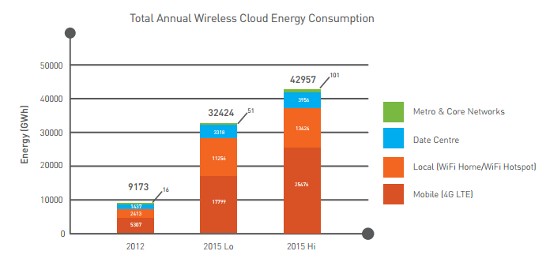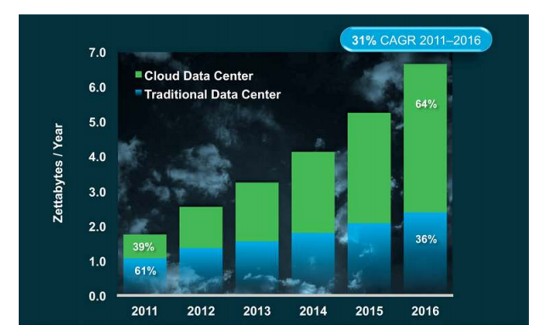Cellular/Wifi bigger polluter than cloud computing
Fri, 26 Apr 2013
cloud hosting, data centres
A recent study by CEET (The Centre for Energy-Efficient Telecommunications) titled ‘The Power of Wireless Cloud: An analysis of the energy consumption of wireless cloud’ has caused a stir amongst telecoms providers and cloud operators. The study claims that the majority of power consumption, up to 90% at a conservative estimate, used when accessing cloud services is spent on the final wireless link to the user device, either through cellular or wifi connectivity.
The study comes as a rebuff to a well documented Greenpeace report titled ‘How clean is your cloud?’, which highlights the power usage of cloud and data centre based infrastructure. The informative CEET study suggests that Greenpeace have ‘missed the point’ and goes on to place the responsibility for CO2 emissions firmly back to the telecoms providers.
The findings are summarised in a chart that shows a break down of each section of the cloud computing and network connectivity loop, from Data Centre and Metro & Network Core to cellular 4G LTE and Local (wifi home / wifi Hotspot). Energy consumption form each section is given to the left. (4G LTE figures are assumed to include 3G coverage).

If the overall growth in energy consumption covering the computing and network loop between today and 2015 were not enough, we are told that the forecast of between 32TWh to 43TWh is highly conservative as it assumes all equipment will be the latest generation and therefore benefiting from technological advances that will reduce power needs. However, a more realistic prediction sets the bar at between 41.5TWh and 58TWh, well over 6 times present demand.
Even on the conservative estimate, and citing the Environmental Protection Agency (EPA) Greenhouse Gas Equivalencies Calculator:
Projected power consumption “… corresponds to an increase in carbon footprint from approximately 6 megatonnes in 2012 to around 30 megatonnes in 2015. This increase corresponds to adding and extra 4.9 million cars onto the roads.”
The 2015 scenario is shocking and clearly reveals the main culprit in modern day internet based cloud access as both the wireless base station and local wifi devices; in other words, not cloud computing per se.
Disclaimers
Whilst interesting, it is important to balance the findings against the statistics. The study admits that:
“Precisely forecasting the power consumption of the wireless cloud is extremely difficult due to the potential variation in the take-up rate of cloud services along with the diversity of possible future services, each involving a particular combination of equipment, data transfer and processing.”
In fact, there are so many variables that it is almost impossible to cite every one. By insisting on examining the convergence between wireless and cloud, the study adds a significant layer of complexity. It describes a modelling process that at each stage errs to the conservative, in other words, to the best case scenario in CO2 emissions and not the worst. Factored in is a value that corresponds to a reduction in power requirements assuming:
- Most networks in 2015 will be running energy efficient technology, not legacy power hungry equipment
- Future data centres have all upgraded to latest generation server and cooling systems, requiring less power
- A discount for networking power overheads that is factored in at each stage, to eliminate traffic not destined for “the cloud”
Furthermore, the study is tenuous in its caveats and assumptions, here regarding local home wifi power assessments:
“The CEET model assumes 2 simultaneous users in the home with each spending approximately 45% and 70% of their online time accessing cloud services in 2012 and 2015 respectively.”
Complexity continues once traffic is on the Metro and Core Network. The CEET study relies on projections offered by the ‘Cisco Global Cloud Index: Forecast and Methodology, 2010 – 2015’, (2011) A chart from this white paper defines what Cisco believes to be the growth in total data centre traffic, split into cloud and non cloud:

Total Data Centre Traffic Growth
Yet any examination of traffic will ultimately come up against near impossible to answer questions such as, how do we define traffic that runs through cloud based equipment and then between data centres? Or between cloud and non-cloud equipment in the same web service cluster?
For example, assume a website and transaction portal powered by a typical ConnetU dedicated server for the front-end, with another dedicated server for a database server. This hardware platform could deliver thousands of smart phone client requests, each requiring cellular or Wifi interaction. Yet under the present CEET model, none of this would be classed as ‘Wireless Cloud’ traffic, as traffic is not destined for a ‘cloud’ service.
On the other hand, if we were to replace our web front-end physical server with two virtual web servers on the ConnetU cloud platform, traffic would now be accessing cloud services – but not all of it, perhaps: there would remain the question in any hybrid cloud environment of how to measure traffic destined for virtual cloud or physical systems.
The CEET Wireless Cloud Energy Consumption Model is, again by it’s own definition, difficult to cross reference, relying as it does on solely on the Cisco Visual Networking Index. We may add that the logic behind any attempt at creating a ‘Wireless Cloud Energy Consumption Model’ is also difficult to comprehend. With two technologies types - wifi / cellular and cloud - deployed simultaneously, each utilising the other, a myriad of practically impossible to measure formats.
The Real Message
Quite possibly, in an attempt to confront the Greenpeace cloud report head on, the CEET study has to some degree missed the point. Surely the focus should be on power demands for all wireless traffic to any destination, not just cloud?
The study, whilst seeming to lose its way somewhat in its obsession with cloud, ultimately does refocus our attention squarely on a major CO2 emitting offender: the cellular tower and local wifi. What is clear is that wireless connectivity is horrendously power hungry, even in comparison to the data centres and cloud stack.
The degree to which the ratio of pollution created by the wireless portion of telecommunications supersedes that of the cloud, or any other part of the data centre/connectivity industries, comes as a surprise to many and warrants a serious response from telecoms companies and governments around the world.
Moreover, as the users of wireless devices, we must face up to our own complicity. It is no longer possible to say that the environmental crime is committed beyond our control in some faceless data centre. The truth is, the damage occurs at each click of an iPhone button.
Come join us on: